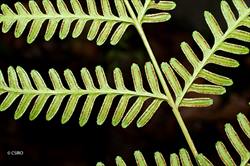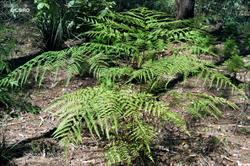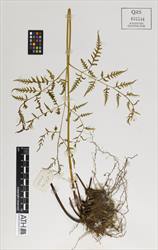Pteridaceae
Australian Tropical Ferns and Lycophytes - Online edition
Pteris tremula





Pteris tremula R.Br.
Link to Australian Plant Name Index for publication details and synonyms: https://id.biodiversity.org.au/name/apni/72910
Tender Brakefern
Large terrestrial ferns. Rhizome short, erect; apex covered with long narrow pale brown scales. Fronds dimorphic, tufted, 30–130 (–200) cm tall. Stipe (15–) 30–60 (–95) cm long, pale brown to chestnut-brown, with a few pale narrow basal scales, or scales absent. Lamina 2–4-pinnate-pinnatifid, ovate-deltoid, 25–60 cm long, 15–40 cm wide, pale green, usually ±herbaceous; rachis red-brown; ultimate segments linear, 10–15 (–30) mm long, decurrent, ±glabrous, but costules on undersurface somewhat hairy. Ultimate sterile segments c. 3 mm wide; margins toothed. Ultimate fertile segments (1–) 1.5 mm wide. Veins free, simple or once- or twice-forked. Sori ±continuous, but absent from bases and apices of ultimate segments; paraphyses absent.
Terrestrial in dry to mesic vine forest or wet sclerophyll forest, sometimes common on roadsides, on disturbed slopes or on creekbanks.
Readily cultivated in the ground or a container in a tropical or subtropical garden or fernhouse.
Field AR, Quinn CJ, Zich FA (2022) Australian Tropical Ferns and Lycophytes. apps.lucidcentral.org/fern/text/intro/index.htm (accessed online INSERT DATE).
Field AR, Quinn CJ, Zich FA (2022) ‘Platycerium superbum’, in Australian Tropical Ferns and Lycophytes. apps.lucidcentral.org/fern/text/entities/platycerium_superbum.htm (accessed online INSERT DATE).







